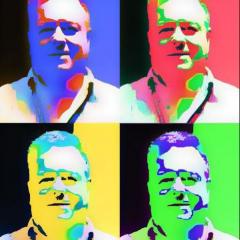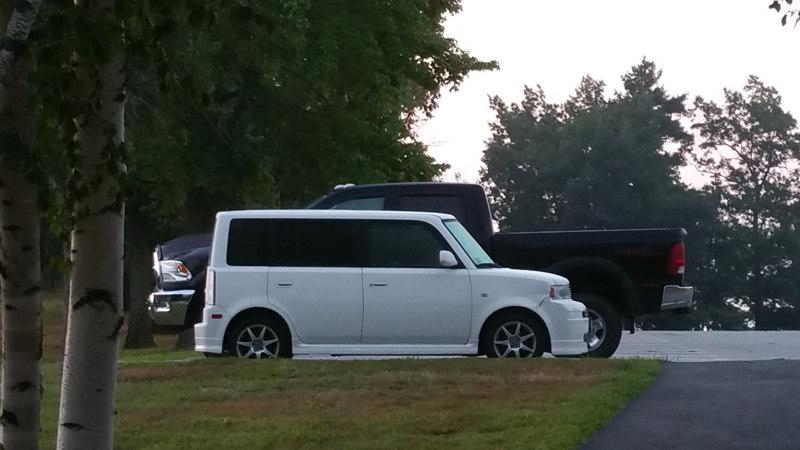-
Posts
9,209 -
Joined
-
Last visited
Content Type
Profiles
Forums
Events
Gallery
Everything posted by peteski
-

1/24th. Vodafone McLaren Mercedes MP4-25 "L. Hamilton"
peteski replied to Luc Janssens's topic in Car Kit News & Reviews
Revell didn't even chrome the "chrome" parts tree in the recently reissued Pointiac Fiero. Draw your own conclusions. They probably want you to buy and use their pricey chrome paint. But then again, maybe they did chrome this kit, and that used up their entire chrome budget, leaving other models with bare plastic "chrome" parts. -
I have driven a Mitsubishi Eclipse GS-T (Turbo) with 5-speed and I did enjoy that slightly laggy turbo kick. While not really topical for this thread, I have also driven a Tesla, and that mash-your-body-into-the-seat rush of INSTANT acceleration is there any time you step in the accelerator (pretty much at any speed). It was very impressive in a sedan without a 700+ hp. internal combustion engine.
-
Wow! Those exact tunes are my top two instrumentals. Now I need to play them! Classical Gas is also near the top of that list.
-

What's with the U.S.Post office these days?
peteski replied to styromaniac's topic in The Off-Topic Lounge
Nice to know that there are still places like where you live. Usually in more rural parts of the country. -

1/24th. Vodafone McLaren Mercedes MP4-25 "L. Hamilton"
peteski replied to Luc Janssens's topic in Car Kit News & Reviews
Yup! I even still have my Nikon SLR (and few lenses), but haven't used it for close to couple of decades. I also see plenty of sexagenarians and older member's on this forum. -

What's with the U.S.Post office these days?
peteski replied to styromaniac's topic in The Off-Topic Lounge
You did the right thing. I hope that the Asst. Post Master will figure out what happened why the clearly marked RTS envelope was returned to you and that this does not happen again. What puzzles me is why (if that lady has been a member of the C/U since before she moved) only a recent single statement (not every month's statement since her move) got sent to her old address (currently yours). The mix-up seems to be at the C/U, but your "return to sender" instructions should have honored by the PO. I wonder if the C/U somehow reverted to using her old address (some computer glitch at the C/U)? I guess if you get another one of her statements next month, we will know. -

What's with the U.S.Post office these days?
peteski replied to styromaniac's topic in The Off-Topic Lounge
I'm assuming that the mail in question was not just some ad (with that lady's name and also "or current resident"), but something more important. While you have no obligation to do this, if I were you I would visit the Postmaster at your local PO to make them aware of this. -

Broken windshield replacement suggestions
peteski replied to V8tiger's topic in Model Building Questions and Answers
Probably because the cockpit usually is the most detailed feature on the entire model airplane. They want to make sure that all those cockpit doo-dads are clearly visible through the thin crystal-clear canopy. I would compare it to the engine compartment of an automotive model. We spend lots of time painting, decaling, plumbing and wiring the engine - we want to be sure it can be clearly visible. In our case, we have an opening hood to expose all that detailed goodness. -

Filling molded in sidemarkers
peteski replied to gtx6970's topic in Model Building Questions and Answers
Looks Good Bill! The only possible worry left would be about ghosting in the paint coat. -

What is your favorite sports car?
peteski replied to WillyBilly's topic in General Automotive Talk (Trucks and Cars)
A bug-eye AH Sprite. A perfect example of a sports car! -
Not quite. It is actually a more modern plastic card. I got that one when I moved in 1992. Still pretty old. The town library back then was in a small single story building. Now it's a large modern multi-story building, while the original structure is used as a town's tax collector office. Also funny that you mentioned the SS card. Just the other day I was looking at that card made of cardboard, with a signature that looks nothing like my current one.
-
Good to see that libraries in the 21 Century are keeping up with the current technological advancements. I still have my local library card somewhere.
-
Orange peel surface is caused by very bumpy paint surface. To make it smooth, those bumps have to be removed until the paint surface is even with the thinnest areas of the paint layer. That is why you will see lots of paint being removed. I would recommend practicing spraying or airbrushing in a way minimizing orange peel. I manage to paint my models in a way no sanding/polishing/buffing is needed. It is doable. Like this one:
-
I would say that they are similar in quality to Tamiya kits. Like Tamiya, many are curbside kits, but in majority of cases, they much better fitting than any of the older domestic brands (MPC, AMT, Monogram, Revell). The "enthusiast series" kits are much more detailed than Tamiya kits, but that means they are also much more complex to build.
-
Thanks for all the train station photos Kaci. I enjoyed them. That ornate canopy over the platforms looks like it's over 100 years old. They don't build them like that anymore. All your models look nice displayed like that. Yes, living quarters in UK are different than in the States. I also noticed the minimalistic ceiling light fixtures. Is that normal in UK apartments? I also get a chuckle seeing those giant mains plugs used in UK. They are so much smaller in the States. When I was growing up in Poland, the plugs were larger than in USA, but nowhere as large as the ones in UK.
-

What is your favorite sports car?
peteski replied to WillyBilly's topic in General Automotive Talk (Trucks and Cars)
Now we're seeing some real sport cars! -

Filling molded in sidemarkers
peteski replied to gtx6970's topic in Model Building Questions and Answers
Here I have another pointer: When using CA glue and activator/accelerator as a filler on plastic surfaces which will have to be sanded smooth, do the sanding within few hours of the CA setting up. At that point it is solid enough, but not fully hardened. When CA (basically type of acrylic) is fully cured, after about 24 hours, it becomes harder than polystyrene most plastic kits are molded from, so when sanding you can likely end up sanding the surrounding plastic lower than the hard CA spot. -

Filling molded in sidemarkers
peteski replied to gtx6970's topic in Model Building Questions and Answers
UV resin in my experience doesn't bond well to styrene (or to any other hard smooth surface). I would be afraid it could pop out sometime in the future. It is also not as hard as styrene. I never used it as adhesive (unless I wanted a temporary bond). -
Oh man, do I miss my "box", "fridge", "toaster"! I had a 2006 Polar white (with a bB badges and some mild mods) from 2006 to 2019. Traded it in when some rust started showing up. I think it had around 120k miles. Bought a 2019 Kia Soul. While it is similar size and shape, it is nothing like the xB. While it has many more luxury features, it is nowhere as easy to get in and out of, the back seat doesn't fold flat and the rear hatch opening is much smaller. It also has less legroom in the back. xB rode nice and low and handled really well. It was also much easier to work on and an excellent printed service manual was available (and often used by me). The Kia only has a PDF-based manual which stinks. Here it is is against a big bad Dodge Ram for size comparison and a chuckle. It is just a bit longer than the truck's wheelbase! Dude, keep yours as long as you can! You'll never find anything even close to it.
-
We already had this covered in. That's where my reply is.
-

Looking for cardboard boxes!
peteski replied to diggerguy's topic in Model Building Questions and Answers
Well Bosco, spill the beans! What is your source for those boxes? Dimensions are similar to the boxes used for promo models. -
I was judging it strictly by its appearance (I'm an Amurican). And even if it is British, to me there are also lots of commonalities between Brits and Aussies (again, from my point of view). But this one for some reason looked Australian to me.
-

So everything new is mo better, huh?
peteski replied to Ace-Garageguy's topic in General Automotive Talk (Trucks and Cars)
Blue dots or not, stickers all over the windshield, etc., what you pointed out happens likely due to the fact that there is severe lack of laws enforcement. You were right on target. It is like we live in a modern Wild, Wild West. It is a free for all without suffering any consequences. -

Filling molded in sidemarkers
peteski replied to gtx6970's topic in Model Building Questions and Answers
In my experience that GOO does shrink. why? Because the added solvent volume while making the GOO evaporates when styrene to get back into solid state (it doesn't cure - it dries). Since the liquid solvent has volume, when it evaporates it leaves the GOO, causing it to shrink. It might not be much shrinkage, but I guarantee it will shrink. That's the scientific explanation. The other problem is that it can take long time (like days, weeks or longer) for all the solvent to evaporate. Again that depends on the thickness of the GOOey repair. I have tried the GOO method and I was not happy with the results. I figured out the reason for shrinkage (same as with any 1-part solvent-based putties), and I never used it again. YMMV. -
Yes, I agree with Tim.





